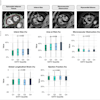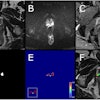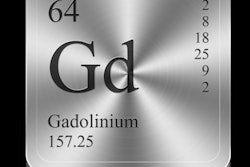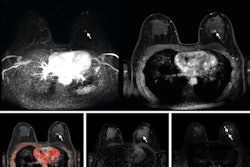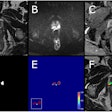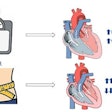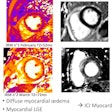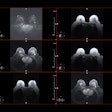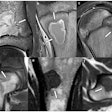Gadolinium-based contrast agents for MRI have contributed to new challenges for marine ecosystems and a greater need for monitoring and mitigation, according to Portuguese scientists.
In an article published in Environmental Pollution on 13 May, Inês Moreira, a Master's student at the University of Aveiro; Rosa Freitas, PhD, an associate professor at the Department of Biology & CESAM, University of Aveiro; and Eduarda Pereira, from the Chemistry Department & REQUIMTE, University of Aveiro plus colleagues performed a literature review of 209 articles on the effects of gadolinium (Gd) contamination in aquatic environments.
“These findings suggest that climate change may not only amplify the direct toxicological effects of Gd but also enhance its persistence in marine ecosystems,” the authors pointed out.
The aim of their study was to examine the distribution and environmental effects of Gd accumulation in marine and coastal ecosystems through analysis of the interactions between wastewater discharge, medical practices, and regulations.
While Gd levels have been historically low, increasing use of Gd-based contrast agents in imaging has resulted in increased presence of it in water bodies, they noted. Chelated Gd residues are not efficiently removed through conventional wastewater treatment systems; furthermore, Gd remains chemically stable and resists natural degradation and thus can persist over long distances through waterways, contaminating ecosystems far from the original source point.
Gd can bioaccumulate in marine life, impairing filtration and reproduction in bivalves, algae, crustaceans, and fish, as well as disrupting photosynthesis in algae and calcium metabolism in fish, the authors explained. Its effects on the food web and ecosystems are longstanding, as Gd persists. As many of these marine species are part of the human diet, assessing the effects and extent of Gd contamination in aquatic ecosystems is essential in determining associated risks to human health, they wrote.
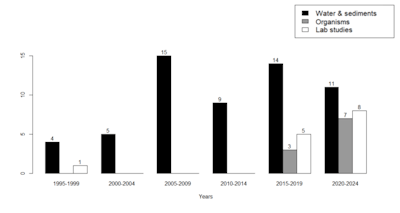 Number of scientific articles published per year, considering the occurrence of gadolinium in marine and coastal environments (water, sediments and organisms) and effects of gadolinium on coastal and marine taxa, under laboratorial conditions.Moreira, Freitas et al, Environmental Pollution
Number of scientific articles published per year, considering the occurrence of gadolinium in marine and coastal environments (water, sediments and organisms) and effects of gadolinium on coastal and marine taxa, under laboratorial conditions.Moreira, Freitas et al, Environmental Pollution
Moreira, Freitas, and colleagues compiled data from a range of studies across geographic regions and different species, as well as over time. Of the 209 published reports on Gd in marine and coastal environments, the authors found, they concentrated on 83 studies that included specific Gd concentrations, with 69 examining Gd concentrations in coastal and marine ecosystems and 14 examining the effects of exposure on marine and coastal species in the laboratory.
Researchers then focused on 83 studies where specific Gd concentrations were studied, with 69 (83.1%) examining Gd concentrations in marine and coastal ecosystems and 14 (16.9%) exploring laboratory exposure effects on marine and coastal species.
The dates of publication ranged from 1995 to 2024, with the number of studies increasing over time, especially lab studies and those focusing on organisms. Geographical distribution varied over time as well: initially, all articles came from Europe and Asia; North America and Oceania contributions emerged, and then South America. While percentages varied over time, the greatest proportion of studies were European consistently.
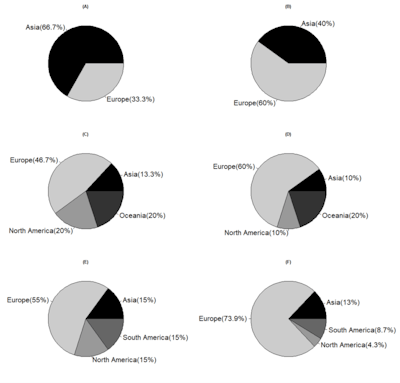 Geographical distribution of scientific publications by continent, in percentage, on gadolinium concentrations in marine and coastal environments (water, sediments and organisms) and effects of laboratory tests. (A) Geographical distribution of scientific articles from the oldest to 1999; (B) Geographical distribution of scientific articles from 2000-2004; (C) Geographical distribution of scientific articles from 2005-2009; (D) Geographical distribution of scientific articles from 2010-2014; (E) Geographical distribution of scientific articles from 2015-2019; (F) Geographical distribution of scientific articles from 2020-2024.Moreira, Freitas et al, Environmental Pollution
Geographical distribution of scientific publications by continent, in percentage, on gadolinium concentrations in marine and coastal environments (water, sediments and organisms) and effects of laboratory tests. (A) Geographical distribution of scientific articles from the oldest to 1999; (B) Geographical distribution of scientific articles from 2000-2004; (C) Geographical distribution of scientific articles from 2005-2009; (D) Geographical distribution of scientific articles from 2010-2014; (E) Geographical distribution of scientific articles from 2015-2019; (F) Geographical distribution of scientific articles from 2020-2024.Moreira, Freitas et al, Environmental Pollution
The authors found 46 studies focused on Gd concentrations in water and 13 studies focused on concentrations found in sediments. In both instances, the range of concentrations was very wide, highlighting the differences between relatively undeveloped areas and those that were industrialized and densely populated.
In particular, the range differences for sediment concentrations were stark. The authors stated that this demonstrated “sediment as a critical sink for Gd retention, often at magnitudes several orders higher than aqueous concentrations.”
As these trends in findings -- the wide range of differences in Gd concentrations between relatively underdeveloped areas and those with high levels of anthropogenic activity, particularly those with limited wastewater treatment capacity -- persisted temporally and geographically in the literature, they underscored the need for continuous monitoring of Gd contamination in aquatic environments, the authors wrote.
Among the aquatic species acting as indicators for the relative health of their ecosystems, the authors mentioned that filter-feeding invertebrates such as Mytilus galloprovincialis (Mediterranean mussel) were among the most frequently studied, as filter-feeding renders them particularly vulnerable to Gd accumulation. They said that the trends in findings, even with laboratory-based studies of marine species, show relevance for climate change.
“As environmental conditions continue to degrade, the long-term consequences of Gd pollution may become more severe, posing significant risks to marine biodiversity and ecosystem function," the group noted. "Given these results, future research should focus on the combined effects of climate change and emerging contaminants, with a particular emphasis on understanding how pollutants like Gd interact with multiple stressors to impact marine life.”
While the authors concluded that research on Gd contamination has followed advances in analytical techniques, they also suggested there are still gaps in knowledge that have not been explored yet -- namely, Gd’s possible interactions with other pollutants, the impact it has on higher trophic levels of marine life, and long-term ecological effects.
The authors affirmed that controlling Gd’s effects on aquatic ecosystems will require multiple levels of coordinated mitigation strategies: internationally coordinated policies and robust monitoring, more effective wastewater treatment technologies, and increased interdisciplinary research. Given the persistence of Gd and its increasing use, the study of its environmental effects and mitigation will remain a central challenge for environmental science, they wrote.
Read the article here. Also worth a read is this paper by the same Portuguese group: Efficient Recovery of Gadolinium from Contaminated Waters Using Manganese Ferrite Nanoparticles. By Joana Sousa et al. Recycling 2025, 10, 57. https://doi.org/10.3390/recycling10020057.

